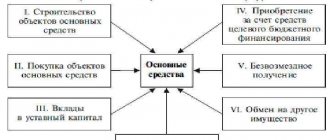The financial result contains all the necessary information on the organization’s activities and is classified into certain categories of income and expenses provided for the reporting year.
Depending on the efficiency of the entire company, the object of checking the financial result is the accounting items of income or expenses, which are the financial result determined for each reporting period of time on the basis of accounting.
The financial result is considered to be the degree of efficiency of the company in the field of production and economic activities, the increase or decrease in the amount of income (loss) over a certain period of time. The final financial result is calculated in accordance with the amount of goods or services sold, the volume of fixed assets of the corporation, as well as non-operating income.
Attention! Income or expenses in the activities of an organization are nothing more than the difference between the amount of income from sales of goods or services at market prices and the costs of production and sales!
The financial results of the organization are presented in several forms - profit and expenses. And if the enterprise’s income exceeds production costs, then all the organization’s activities are considered effective. If a level of costs exceeds the amount of income of the enterprise, the work is treated as unprofitable.
Profit is the final positive financial result of the organization’s performance, and loss is negative.
The profit of any organization is generated through the following sources:
- From the sale of goods or provision of services, which is the operating activity of the company. It shows the final result from the organization’s main field of activity in the market and its profile;
- From the sale of property - characterized by the sale of tangible and intangible assets, securities, and so on;
- From non-operating transactions. This includes interest on shares purchased, income from the use of debt obligations, etc.
The following types of profit are distinguished:
- Gross profit (the main type of profit among others) is income from the sale of goods, services or work minus the cost of the object sold;
- Revenue from sales. To determine what profit from sales is, it is necessary to subtract expenses (both managerial and commercial) from gross profit;
- Balance sheet profit – income from sales excluding the balance of other items of income and expenses;
- Profit from taxation;
- Net profit of the reporting period.
The main functions of profit include:
- Estimated - the essence of which is that with the help of relative and absolute parameters of profitability you can find out the actual efficiency of the organization, quality and overall activity. In addition, by looking at the income item, you can find out such aspects as the quality of the enterprise’s resources (labor, material and production) and labor productivity;
- Stimulating , which shows the degree of satisfaction of the organization’s employees with their work, whether their social needs are taken into account, as well as the procedure for paying dividends.
Indicators of financial performance of the enterprise
All these important values for the organization show the absolute effectiveness of the organization’s management in all areas of activity: financial, production, sales, investment and supply. They form an assessment of the company’s economic management, as well as its relationship in a market economy.
Attention! To analyze financial results, appropriate coefficients are used to adjust the values of the financial statements. Its key components are analysis and calculation of resource efficiency, as well as profitability.
It is possible to evaluate the activity of an enterprise from the point of view of financial values thanks to relative and absolute indicators. The first includes all kinds of profit-cost ratios.
The Role of Accounting in Financial Assessment
Accounting for financial results is carried out through several accounts. Their choice depends on the specifics of the activity that generated income or incurred expenses. If you received income from the activities specified in the articles of incorporation, the income should be treated as received from ordinary activities. For all other cases, “other activity” accounts are provided, which are designed to record income and expenses associated with procedures that are not typical for the work of the company.
Other income may include income from the investment of securities, positive differences in exchange rates, or surpluses discovered during inventory. This category also includes the receipt of debts that have already been written off due to the expiration of the statute of limitations and similar receipts that are not directly related to the commercial activities of the company.
Other expenses may include fines, penalties and other payments that may be collected by regulatory authorities or counterparties. Negative differences due to exchange rate fluctuations or receivables for which the statute of limitations has expired fall into the same category.
There are three main accounts for recording financial results:
- 90 "Sales";
- 91 “Other income and expenses”;
- 99 "Profits and losses."
To take into account other expenses, the specialist needs to post them in two accounts: 91 and 99. That is, first the profit from the activity is reflected in the accounting, and then the loss.
Determination of the financial result of the enterprise's activities
Every month, company accountants calculate the financial results of their organization, correlating the turnover in accounts 90 and 91. The resulting result is recorded in account 99 “Profit and Loss”. The order of its determination is as follows:
The result from the main area of activity is taken into account in account 90, and the item of other income and expenses is entered in account 99, which in turn shows income tax and fines associated with tax violations. In other words, account 99 forms a debit or credit balance, which is written off by the final entry of the reporting year on account 84 “Uncovered loss (retained earnings).”
For example, if at the end of the year the company made a profit, then the corresponding entry is made, the order of which is as follows: The net profit of the reporting period is written off. In case of a loss, the net loss of the reporting period is reflected.
Reflection of the financial results of the organization’s activities
The financial results of the company are among the key indicators of economic efficiency, in accordance with which management decisions are made. The financial result is an increase or decrease in the price of the enterprise's equity capital based on the activities for the reporting year.
Account 99, called “Profit and Loss,” is used to collect information about the creation of the final financial result of the enterprise’s activities for the reporting period.
Attention! The final financial result consists of values such as results from primary and secondary activities, accrued income tax and the amount of tax penalties.
The financial result of the reporting year is not taken into account as a separate value in the balance sheet, but is included in the amount of residual profit for the entire life of the organization.
In company accounting, accounting entries are reflected in debit and credit accounts.
Financial result: formula
The result of the company's work in the period under review is displayed as revenue from the sale of the manufactured product, and the final financial result - as profit and net profit. It is the amount of net profit, which is the final result, that the economist focuses on. The calculation is carried out in stages, since profit is an ambiguous concept and there are several types of it:
- Gross;
- From implementation;
- Before tax;
- Clean.
When starting the calculation, the accountant uses the following formulas:
- Gross profit (GP) = Вр - Срт, where Вр - sales revenue, Срт - cost of goods sold;
- Profit from sales (Pr) = VP – KR – UR, where KR and UR are commercial/administrative costs;
- Profit before tax (Pdon) = Pr + Dvo – Pvo, where Dvo and Pvo are operating/non-operating expenses and income;
- Net profit (NP) = Pdon – N, where N – taxes and tax liabilities.
The formulas used make it possible to calculate the financial result, which shows how efficiently the company operated in the reporting period. Now let’s figure out what accounting records this indicator is recorded in.
Formation
The financial result is based on the profit or loss of the enterprise. Profit is the difference between the company's revenue or income from the production and sale of its products and the sum of all costs incurred. You should not equate the income of an enterprise with its profit, since income is the sum of all funds received by the enterprise as a result of the production and sale of products without taking into account costs. It depends, in turn, on the volume of products produced and the price of its sale. Thus, the higher the income received, the higher the net profit can be, and vice versa.
Obtaining maximum profit involves minimizing production costs. In the case when costs exceed the amount of funds received, the enterprise’s profit is negative and it suffers losses, which means it receives a negative financial result.
Profit goes through several stages of its formation:
- Fixed costs in the form of mandatory payments are subtracted from total revenue and net revenue is formed. Such payments may include VAT and excise taxes.
- The difference between net revenue and the cost of the product, equal to the cost of its production, is calculated. The resulting amount is called gross profit.
- From the resulting gross profit, operating costs such as advertising or management expenses are subtracted, and the result obtained is the profit from sales.
- Balance sheet profit is formed; for this, the balance of other income and expenses is subtracted from the profit received from sales.
- Taxation is subtracted from the balance sheet profit and the resulting result is the final net profit.
Thus, there are several types of profit, the formation of which occurs in stages. The financial result is most accurately displayed at the last stage.
Functional basis
In general, financial results perform two key functions: evaluative and motivating. In the first case, it reflects the quality and efficiency of the company's production activities. Being the result of the production and sales process, it shows how efficiently and effectively the enterprise operated and used the available resources. In this regard, when evaluating a company, for example, by investors, their attention is focused specifically on the financial result or on the change in the company’s profit. A positive increase in profit over recent periods indicates the efficiency of the company and confirms the advisability of investing in it. The second function of the financial result involves stimulating the enterprise to develop, improve performance and quality of products, and, accordingly, the financial result of the activity itself. Indeed, if the enterprise lacks the desire to develop and increase profits, its prospects are extremely doubtful, especially in the face of high competition.
The financial result of any enterprise is the final indicator of its activity, which is determined by its profit. Its key role is confirmed by the fact that it simultaneously serves as both an evaluation indicator of the enterprise and an incentive for its further development.
The main tasks of analyzing financial results
- systematic monitoring of the implementation of sales plans;
- determining the influence of objective and subjective factors on the work of the company;
- search for reserves to increase profits and profitability of the enterprise;
- development of strategies and ways to use reserves.
The main sources of information for accounting and analysis of financial results are accounting data, reporting and tables of the enterprise’s business plan. Nowadays, a large number of different methods and methods of financial analysis are used. You can order analytical research from third-party specialists or contact in-house employees with suitable qualifications.
Features of the analysis of the company's financial results
Analysis of financial results involves the study of profits and losses in their absolute values and relative ratios. In other words, this is a comprehensive study of when and from what sources finances come to accounts and where the company’s funds go.
Financial result is a general term. It covers both profit, which characterizes the activities of the enterprise, and profitability indicators. The difference between the first and second data is that profitability demonstrates how effectively the company manages its own funds and what costs it incurs. If profit is an absolute value, then profitability is a relative indicator.
After analyzing the financial results, specialists objectively evaluate such important parameters as the investment attractiveness of the organization and the prospects of the business. In other words, analysis of financial results allows you to assess the company’s position in the market, the possibility of attracting investors and obtaining loans. The results of a study of the profit and profitability of a business can help find additional sources of financing or allocate existing resources more rationally.
Accounting for the use of profits
The so-called net profit is reflected at the end of each year in account 84 - it can appear only after the company has already paid taxes. Uncovered losses are accounted for through the same account. The company must distribute its profits and use them rationally. With losses, things are more complicated. How can you cover the company's financial losses? This is done from reserve or additional capital, but in some cases the company may attract additional deposits. So, the final financial result is calculated at the end of the year. It is reflected through accounts 99 and 84.
Profit is the goal of any commercial company. Its presence indicates that the work of the enterprise is organized quite efficiently. However, profit by itself is not enough for an organization to develop. Therefore, it is important not only to take into account financial results, but also to evaluate the efficiency of using profits. The responsibility to determine where the funds will be directed falls on managers. Most often, net profit is used to pay off losses from previous periods, form reserve capital, expand and modernize the business, or pay dividends.








